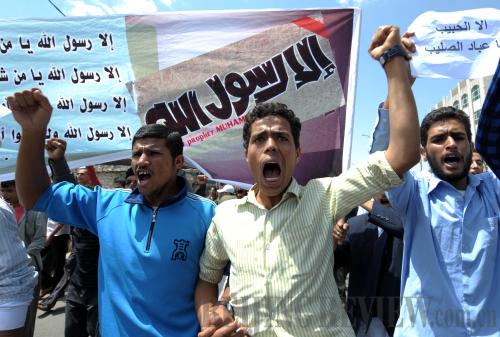|
 |
|
LASTING ANGER: Demonstrators protest against a film produced in the United States insulting Prophet Muhammad in Sanaa, the capital of Yemen, on September 13 (XINHUA) |

For several weeks in September, a wave of demonstrations against the United States, and Western countries in general, swept the Muslim world. The initial cause for the anger was a trailer of a film deriding the Prophet Muhammad. The Prophet Muhammad is a highly sensitive subject in the Islamic world, and he cannot be ridiculed in the slightest.
Differing cases
Though the demonstrations are widespread, we should stay mindful of the Middle East's diversity. Analysis of the events should be based on individual cases. For instance, Libya, the worst-hit country, is in a post-civil war situation. Militias with various ideologies, weapons and political demands emerged during the war against the Muammar Gaddafi regime. They are not loyal to the transitional governing body, and security troops are decentralized with limited capability. Under such a weak security environment, demonstrations can easily turn violent. The U.S. Embassy even became the target. It was a grave tragedy that U.S. Ambassador Chris Stevens was killed.
Compared to Libya, Egypt is relatively under control. There were clashes between police and civilians for days, leaving hundreds wounded, but foreign embassies remained largely safe from violent attacks. The Egyptian authorities clearly have a much better security structure than Libya. The new regime led by the Muslim Brotherhood cares about appeals of the populace. President Mohamed Morsi strongly condemned the film, and although he cannot stop mass protests, he can at least prevent foreigners from being killed.
The next most volatile area is Afghanistan and Pakistan. Unlike countries in the Middle East, where the United States isn't playing an active wartime role, Afghanistan and Pakistan are still a battleground. The United States carries on with its antiterror war, with drones bombing suspected terrorist enclaves and frequently killing civilians in the process. The people of these countries are already deeply resentful of the United States, so it is unsurprising that they would take to the streets to express their anger. Earlier, large-scale demonstrations broke out following U.S. soldiers' incineration of the Quran in Afghanistan in February, causing 30 deaths. The region could not accept another blasphemous incident in such a short time.
The demonstrations in Yemen and Sudan also turned into riots against U.S. embassies. Yemen is somewhat similar to Afghanistan and Pakistan. The United States has struck Al Qaeda militants there, killing several key figures in recent years. Washington may think it is helping Yemen, but Yemeni people disagree. They showed their true feelings to their pro-American President Abd-Rabbu Mansour Hadi in these protests. Meanwhile, for decades the United States defined Sudan as a "rogue nation." The United States sanctioned Sudan and supported the separation of South Sudan to weaken the country. After the independence of South Sudan in 2011, the United States remained reluctant to change its policy toward Sudan. The Sudanese Government would like to seize on this popular movement to express its own dissatisfaction with Washington.
|
